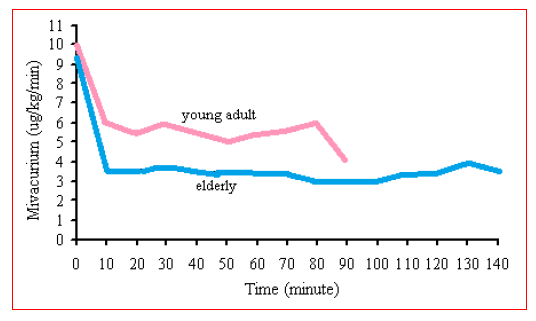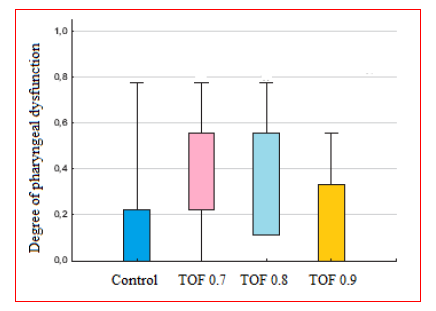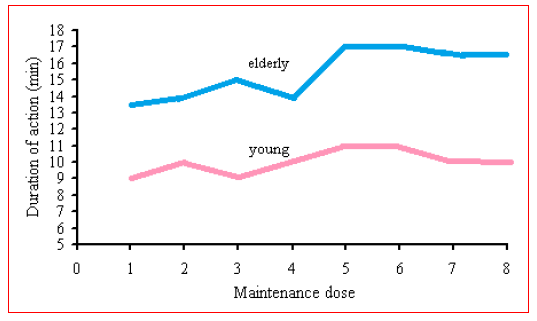Journal of
eISSN: 2373-6437


Mini Review Volume 5 Issue 1
Consultant Intensive Care Medicine at Private practice clinic, Iraq
Correspondence: Fadhil Zwer, Consultant Intensive Care Medicine at Private practice clinic, Iraq
Received: April 19, 2016 | Published: June 1, 2016
Citation: Zwer F (2016) The Role of Neuromuscular Blocking Drugs in Elderly Patients. J Anesth Crit Care Open Access 5(1): 00170. DOI: 10.15406/jaccoa.2016.05.00170
Aging is associated with progressive decreases in skeletal muscle mass and strength (sarcopenia) caused by reduction of anabolic hormone concentration, decline in muscle protein turnover and other neuromuscular alterations. Between 20 and 80 years of age the cumulative decline in skeletal muscle mass amounts to 35-40%. The loss of muscle mass is not associated with weight loss because of a corresponding increase in fat. Loss of muscle mass, particularly the preferential loss of type II fibers, is results in diminished strength and power -generating capacity. This has been attributed to structural changes in myosin caused by protein oxidation. The aging is also associated with a slowing of time and rate of relaxation of skeletal muscle probably caused by decreased rates of maximal sarcoplasmic reticulum Ca2++ uptake and sarcoplasmic reticulum Ca2++–ATPase activity. Anyhow, the loss of muscle mass associated with aging may be of multifactorial etiologies.
The exchange of trophic factors by motor neurons and muscle fibers maintains the neuromuscular junction. Neurotrophic factors (muscle-derived trophic factors acting on motor neurons) and myotrophic factors (motor neuron-derived trophic factors acting on muscle fibers) may play a role in the generation of secondary myotubes and the maturation of neuromuscular junctions during development. It has been suggested that the expression of the trophic factors and their receptors (trk B) might be altered with age, resulting in synaptic dysfunction and cell death. Trk B is a family of transmembrane proteins composed of a tyrosine kinase that serve as receptors for brain-derived neurotrophic factor, neurotrophin-3 and neurotrophin-4/5.
Aging is also associated with a reduction in total muscle fiber number. A substantial selective atrophy of fast glycolytic type II fibers was observed with aging. It is believed that type II fibers have a reduced re-innervation capacity compared with type I fibers. The specific force developed by both fast and slow twitch single intact muscle fibers declines with aging and more significantly in the fast-twitch fibers. In persons aged > 60 years a reduction in number of α-motor neurons and their myelinated axons were observed in lumbar ventral roots. Axonal atrophy is probably caused by a reduction in the expression and axonal transport of cytoskeletal proteins in the peripheral nerve. For neuromuscular junctions, aging is associated with a decrease in motor unit numbers. In some junctions motor neurons regenerate by sprouting and formation of new sites. The newly formed synaptic sites appear to be unstable and with many are disappearing within several weeks. Greater complexity of terminal arborization is observed in the elderly neuromuscular junctions than those in the adult. Areas of axonal contact become progressively very few with advancing age leading to a reduction of the effective area of synaptic contact in the neuromuscular junction. This can result in a decline in the trophic interaction of nerve and muscle and in impairment of stimulus transmission. The repeated cycles of retraction and compensatory outgrowth probably represent the altered balance between degeneration and regeneration of nerve terminals. The greater complexity of terminal arborization may reflect an adaptive and reactive response at the neuromuscular junction in an attempt to preserve synaptic area and to compensate for the loss of adhesion of nerve terminals to the synaptic matrix or surrounding Schwann cells. The cellular mechanisms underlying these changes are unclear although a deficiency of actin has been proposed by some investigators.
The adaptive process to aging at the neuromuscular junction includes:
Although function may be initially preserved, the increasing extent of adaptation means a progressively more fragile system. Increased fragmentation and loss of active synaptic areas can lead to deterioration of neuromuscular junction structure and function. Therefore, the capacity of skeletal muscle to generate force will declines with age. In the elderly the diaphragm undergoes significant reduction in specific force. This will increase the workload on the diaphragm.
Not only the functional changes at the neuromuscular junction but also the multitude of physiologic changes that accompany the aging process [decreases in total body water, glomerular filtration and renal blood flow, liver mass and splanchnic blood flow, serum albumin concentrations and increase in fat] affect the action of neuromuscular blockers in the elderly. In general the onset of nondepolarizing neuromuscular blocking drugs is delayed in the elderly compared with the young. The physiological changes that occur with increasing age mostly possess significant effects on the pharmacokinetics of neuromuscular blocking drugs. Changes in cardiac output can affect drug distribution and therefore the speed of onset of neuromuscular block. A decrease in muscle mass and increase in body fat with age can also affect their distribution. The deterioration in renal and hepatic function associated with aging affect the clearance and elimination of many neuromuscular blocking drugs. The effects of these physiological changes on the pharmacokinetics of neuromuscular blocking drugs may not become apparent clinically in healthy individuals until the age of at least 75 years is reached. However, there are very little evidences to suggest any alteration in the sensitivity of the neuromuscular junction to neuromuscular blocking drugs with increasing age. Neuromuscular blocking drugs that undergo a significant degree of organ-dependent elimination such as pancuronium, vecuronium, rocuronium, and doxacurium, may have a significant prolonged duration of action in elderly patients. However these drugs can be used safely in elderly patients if the anesthetist is aware of their altered pharmacokinetics in this patient group. Anyhow appropriate changes must be made to drug dosage and dose intervals. As the pharmacokinetic changes can be unpredicted, monitoring of neuromuscular block is strongly advised when using these drugs in old age patients (Figure 1).

Figure 1 The duration of action of mivacurium is prolonged in the elderly and infusion requirements are lower compared with young adults.
The risk of residual block occurring postoperatively after the use of pancuronium increases with age. The duration of action of mivacurium may also be prolonged in the elderly, these changes has not been demonstrated to be a result of an alteration in plasma cholinesterase activity. In contrast, there is no evidence of an alteration in the action of suxamethonium with increasing age. The duration of action of mivacurium is prolonged in the elderly by approximately 30% and infusion requirements are lower by a similar amount compared with young adults (Figure 1). A recent report has shown that pseudocholinesterase activity is significantly lower in elderly compared with adults although it is stillwell within the normal range. It has also been shown that there is an inverse relationship between pseudocholinesterase activity and duration of action of mivacurium. A decrease in plasma cholinesterase activity may therefore be the reason for the longer duration of action of mivacurium in the elderly. A reduction of this extent in plasma cholinesterase activity in those with phenotypically normal enzyme is, however, not usually associated with prolongation of the effect of suxamethonium; the enzyme activity needs to be reduced by nearly 70% for such an effect to occur. However, it is possible that metabolism of mivacurium is affected much more than that of suxamethonium, even with smaller decreases in pseudocholinesterase activity. Mean infusion requirements in the elderly and young adults are 3.67 and 5.5 ug/kg/min respectively. The differences between the two age group are significant. In young adults the partial neuromuscular block increases the incidence of pharyngeal dysfunction. In the elderly, this extended to a majority of swallows, despite limited depth of block. This cannot be explained by age-dependent differences in neuromuscular blocking drugs potency. Rather, it is likely that age-induced decline in pharyngeal function reduces the margins of safety during swallowing and so accentuates the effects of neuromuscular blocking agents. Hence, elderly are prone to adverse pharyngeal effects of residual neuromuscular block. However, these effects may remain longer because of the decreased elimination rate of neuromuscular blocking drugs in elderly, further increasing the risk for pulmonary complications. Anyhow, during partial neuromuscular block, the degree of pharyngeal dysfunction increased three-fold, and more swallows showed multiple signs of dysfunction. It is found that the partial neuromuscular block in healthy elderly individuals cause an increased incidence of pharyngeal dysfunction, from 37 to 71%, with impaired ability to protect the airway (Figure 2). So the appropriate management of neuromuscular function including avoidance of residual neuromuscular block in the postoperative period is of utmost importance in the elderly (Figure 3). Atracurium and cisatracurium are undergoes predominately organ independent elimination. However onset of block with these two drugs may be prolonged in the elderly, but their clinical duration of action does not alter significantly with age compared with prolongation of action in case of for example rocuronium and vecuronium. These characteristics of cisatracurium and atracurium make them particularly suitable for use in this patient group. Although atracurium may cause histamine release, there are little evidences of whether it producing hemodynamic changes in the elderly. Cisatracurium has very little direct or indirect cardiovascular effects and is therefore the most suitable neuromuscular blocking drug to be preferably used in old age patients.

Figure 2 Degree of pharyngeal dysfunction at control and during three levels of partial neuromuscular block TOF ratios 0.70, 0.80, and > 0.90. Severity of pharyngeal dysfunction increased significantly during partial neuromuscular block in the elderly and an increased number of swallows showed multiple abnormalities.

Figure 3 The reason for the prolonged duration of action in the elderly is a decrease in renal and hepatic perfusion associated with aging.
In the elderly, the onset of action and recovery of block of rocuronium are slightly slower than in the young but the potency is similar. The most likely reason for the prolonged duration of action in the elderly is a decrease in renal and hepatic perfusion associated with aging (Figure 3).
The duration of action of neostigmine and pyridostigmine is reported to be prolonged in the elderly, probably because of reduction in plasma clearance. However, it has been shown that a greater dose of neostigmine is required in the elderly than in the young patients to produce adequate antagonism of neuromuscular blockade. Aging is associated with a prolongation of the elimination half-life and a reduction of the plasma clearance that resulted in higher plasma concentration of edrophonium. However, this is not reflected in an increased duration of antagonism in the elderly as compared with younger patients.
None.
Author declare that there is no conflict of interest.
None.

©2016 Zwer. This is an open access article distributed under the terms of the, which permits unrestricted use, distribution, and build upon your work non-commercially.